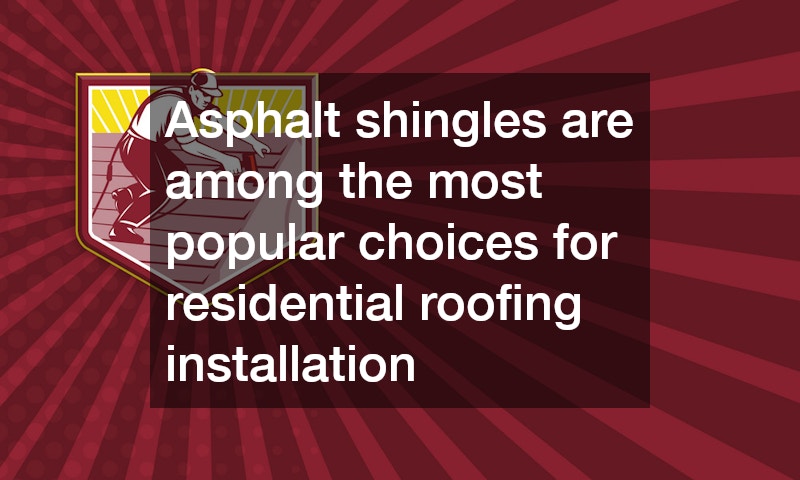
When undertaking a roofing installation project, one of the primary considerations is the choice of materials. Different materials offer various benefits, and understanding these can help homeowners make informed decisions. Factors such as climate, budget, and aesthetic preferences generally guide the choice of roofing materials.
Roofing materials have evolved significantly over the years. From the traditional thatched roofs of ancient times to modern synthetic options, the industry offers a wide array of solutions to meet diverse needs. Amidst this vast selection, it is essential to focus on durability, maintenance, and environmental impact.
Choosing the right roofing material is crucial not only for the functionality of a home but also for its overall value. The appearance and quality of a roof can significantly influence curb appeal, which is a critical consideration for homeowners planning to sell. Moreover, selecting eco-friendly materials has increasingly become a priority for sustainable living.
Asphalt Shingles
Asphalt shingles are among the most popular choices for residential roofing installation. They are favored for their affordability and relatively simple installation process. Composed of a fiberglass base topped with asphalt and mineral granules, these shingles offer a waterproof layer to the roofing structure.
In addition to their cost-effectiveness, asphalt shingles come in various colors and styles, allowing homeowners to match their roof with the architectural design of their house. Despite their popularity, however, they do have drawbacks such as a shorter lifespan compared to other materials like metal or slate. Regular maintenance and inspections are necessary to prolong their effectiveness and avoid issues such as leaks.
Asphalt shingles perform well in various climates, but extreme temperature fluctuations can impact their durability. Furthermore, their production involves certain environmental concerns, but innovations in recycling programs are helping reduce their ecological footprint. Ultimately, they remain a reliable option for many homeowners seeking a balance between cost and performance.
Metal Roofing
Metal roofing has gained popularity due to its longevity and resilience. Made from materials such as steel, aluminum, or copper, metal roofs are known for their durability and resistance to harsh weather conditions. They are especially advantageous in areas prone to extreme weather events like heavy snowfall or hailstorms.
One of the significant benefits of metal roofing is its energy efficiency. Reflective coatings on metal roofs can reduce cooling costs by deflecting sunlight, making them an attractive option for homeowners looking to minimize energy bills. Additionally, metal roofs are low-maintenance and can last up to 50 years or more with proper care.
Despite the higher upfront costs, the long-term savings on repairs and energy can make metal roofing a cost-effective choice over time. Furthermore, many metal roofing materials are recyclable, contributing positively to environmental sustainability. The aesthetic variations available in metal roofing also cater to diverse architectural styles, further enhancing their appeal.
Slate Roofing
Slate roofing is renowned for its elegance and unmatched durability. This natural stone material offers a classic, sophisticated look, enhancing the architectural beauty of a building. While it is one of the more expensive roofing materials, its longevity can sometimes justify the investment.
With a lifespan that can exceed 100 years, slate is often considered one of the most durable roofing options. Its natural fire resistance and low water absorption help it withstand various weather conditions. However, the installation process is more complex and requires specialized skills, emphasizing the importance of choosing an experienced roofing contractor.
Slate is a heavy material, which may necessitate structural reinforcement of the roof, adding to the installation cost. Despite these challenges, it remains a preferred choice for homeowners seeking a timeless roof that promises both beauty and function. Additionally, using salvaged slate tiles can further enhance the sustainability of this choice.
Tile Roofing
Tile roofing has been a staple in certain regions, particularly those with Mediterranean or Spanish architectural influences. Made from materials like clay or concrete, tiles are valued for their aesthetic appeal and durability in specific climates. They provide excellent insulation, helping to regulate indoor temperatures efficiently.
Like slate, tile roofing is known for its longevity and can last 100 years or more with proper maintenance. However, the weight of tile requires a robust supporting structure, which can increase the overall cost of installation. Despite these factors, tile roofs offer exceptional weather and fire resistance.
Homeowners often choose tile roofing for its stunning visual impact and potential to enhance property value. Additionally, improvements in manufacturing techniques have led to a wider array of styles and colors, expanding the design possibilities. For environmentally conscious homeowners, many tile products are made from sustainable materials like recycled content.




